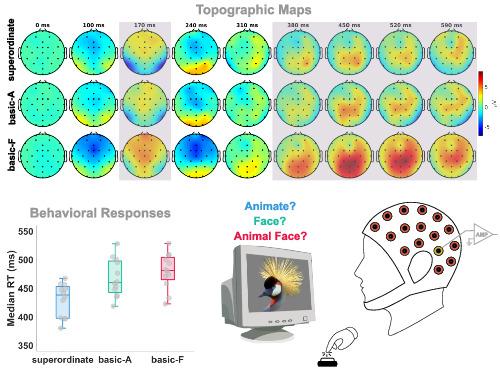当前位置:
X-MOL 学术
›
Eur. J. Neurosci.
›
论文详情
Our official English website, www.x-mol.net, welcomes your
feedback! (Note: you will need to create a separate account there.)
Task-dependent neural representations of visual object categories
European Journal of Neuroscience ( IF 2.7 ) Pub Date : 2021-09-04 , DOI: 10.1111/ejn.15440 Amirhossein Farzmahdi 1 , Fatemeh Fallah 2 , Reza Rajimehr 3 , Reza Ebrahimpour 2
European Journal of Neuroscience ( IF 2.7 ) Pub Date : 2021-09-04 , DOI: 10.1111/ejn.15440 Amirhossein Farzmahdi 1 , Fatemeh Fallah 2 , Reza Rajimehr 3 , Reza Ebrahimpour 2
Affiliation

|
What do we perceive in a glance of an object? If we are questioned about it, will our perception be affected? How does the task demand influence visual processing in the brain and, consequently, our behaviour? To address these questions, we conducted an object categorisation experiment with three tasks, one at the superordinate level (‘animate/inanimate’) and two at the basic levels (‘face/body’ and ‘animal/human face’) along with a passive task in which participants were not required to categorise objects. To control bottom-up information and eliminate the effect of sensory-driven dissimilarity, we used a particular set of animal face images as the identical target stimuli across all tasks. We then investigated the impact of top-down task demands on behaviour and brain representations. Behavioural results demonstrated a superordinate advantage in the reaction time, while the accuracy was similar for all categorisation levels. The event-related potentials (ERPs) for all categorisation levels were highly similar except for about 170 ms and after 300 ms from stimulus onset. In these time windows, the animal/human face categorisation, which required fine-scale discrimination, elicited a differential ERP response. Similarly, decoding analysis over all electrodes showed the highest peak value of task decoding around 170 ms, followed by a few significant timepoints, generally after 300 ms. Moreover, brain responses revealed task-related neural modulation during categorisation tasks compared with the passive task. Overall, these findings demonstrate different task-related effects on the behavioural response and brain representations. The early and late components of neural modulation could be linked to perceptual and top-down processing of object categories, respectively.
中文翻译:

视觉对象类别的任务相关神经表示
我们从一个物体的一瞥中看到了什么?如果我们被质疑,我们的认知会受到影响吗?任务需求如何影响大脑的视觉处理,进而影响我们的行为?为了解决这些问题,我们进行了一项包含三个任务的对象分类实验,一个在上级(“有生命的/无生命的”),两个在基本的级别(“脸/身体”和“动物/人的脸”)以及一个不要求参与者对物体进行分类的被动任务。为了控制自下而上的信息并消除感官驱动差异的影响,我们使用一组特定的动物面部图像作为所有任务中的相同目标刺激。然后,我们研究了自上而下的任务需求对行为和大脑表征的影响。行为结果表明反应时间具有超强优势,而所有分类级别的准确性都相似。除了大约 170 毫秒和刺激开始后 300 毫秒之外,所有分类级别的事件相关电位 (ERP) 都非常相似。在这些时间窗口中,需要精细区分的动物/人脸分类引发了不同的 ERP 反应。类似地,对所有电极的解码分析显示任务解码的最高峰值在 170 毫秒左右,然后是一些重要的时间点,通常在 300 毫秒之后。此外,与被动任务相比,大脑反应揭示了分类任务期间与任务相关的神经调制。总体而言,这些发现证明了对行为反应和大脑表征的不同任务相关影响。
更新日期:2021-10-20
中文翻译:

视觉对象类别的任务相关神经表示
我们从一个物体的一瞥中看到了什么?如果我们被质疑,我们的认知会受到影响吗?任务需求如何影响大脑的视觉处理,进而影响我们的行为?为了解决这些问题,我们进行了一项包含三个任务的对象分类实验,一个在上级(“有生命的/无生命的”),两个在基本的级别(“脸/身体”和“动物/人的脸”)以及一个不要求参与者对物体进行分类的被动任务。为了控制自下而上的信息并消除感官驱动差异的影响,我们使用一组特定的动物面部图像作为所有任务中的相同目标刺激。然后,我们研究了自上而下的任务需求对行为和大脑表征的影响。行为结果表明反应时间具有超强优势,而所有分类级别的准确性都相似。除了大约 170 毫秒和刺激开始后 300 毫秒之外,所有分类级别的事件相关电位 (ERP) 都非常相似。在这些时间窗口中,需要精细区分的动物/人脸分类引发了不同的 ERP 反应。类似地,对所有电极的解码分析显示任务解码的最高峰值在 170 毫秒左右,然后是一些重要的时间点,通常在 300 毫秒之后。此外,与被动任务相比,大脑反应揭示了分类任务期间与任务相关的神经调制。总体而言,这些发现证明了对行为反应和大脑表征的不同任务相关影响。











































 京公网安备 11010802027423号
京公网安备 11010802027423号